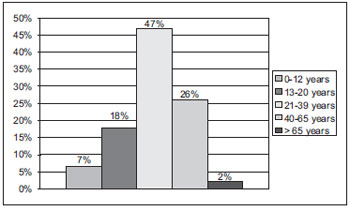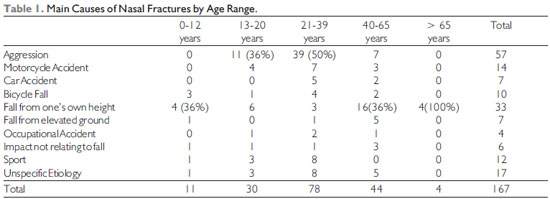INTRODUCTIONThe nasal fractures are one of the most frequent services performed by the otorhinolaryngologist (1). Like other facial traumas, they affect mostly the male sex and the mostly affected age is between 20 and 30 years of age (2,3).
Among this affection most frequent causes are the interpersonal violence, the physical activities, falls, car crashes, motorcycles accidents, impact not relating to fall, occupational accident and unspecified etiology (2).
Due to its prominent position on the face, the nose is more prone to traumas, which are the most frequent type.
In the nasal fracture suspicion, one must always question about the history of epistaxis, nasal obstruction, nasal appearance change and pain, because, when these are present, such data help confirm the diagnosis.
As for the evaluation of the nasal trauma consequences, a gold standard is missing. The exam is commonly made in a subjective manner (4).
There is no uniform protocol for this condition manipulation. There are several approaches reported such as manual reduction, manual approach associated to forceps, the one uniquely performed with forceps, the carrying out of associated septoplasty and even rhinoseptoplasty. The nasal bones manipulation may be practiced without anesthesia, with local anesthesia and general anesthesia (1).
The objective of this study is to verify the age, sex and the most frequent causes of the nasal fractures treated in a tertiary hospital.
METHODThe records of patients with nasal fracture diagnosis attended in the period from July 1st, 2003 through July 1st 2007 were retrospectively evaluated. The diagnosis was based on the clinical history, physical exam and, in some cases, nasal bones radiography. The patients who presented with nasal trauma history without fracture confirmed in physical exam or radiography were excluded. The work was approved by the Ethics Committee of the Regional University Hospital of the North of Paraná, under protocol no. 0033.0.268.000-08. The data completion was ordered as follows:
Date:
Hospital Register:
Sex:
Age:
Fracture Cause:
RESULTS167 cases were evaluated in the study, and they were 134 male patients and 33 female patients. The most affected age range was from 21 to 39 years (Graphic 1). The most frequent causes were physical aggression and fall from their own height (Graphic 2). We also observed physical aggression was more present between 21 and 39 years and fall from their own height after 40 years old (Table 1).

Graphic 1. Distribution of Nasal Fractures by Age Range.

Graphic 2. Causes of Nasal Fractures.

There are a few works that address the nasal trauma separately; such theme is generally approached along with general facial trauma. As the most prominent position organ is the face, it's the most affected location in this trauma and it's possible to compare the nasal trauma etiology separately with that of the facial trauma.
The male sex, as verified in other studies, was widely the most affected (80.2%). An information similar to that found by Bakardjiev (5), who found a ratio of 4 men per 1 woman with facial trauma, and Wulkan (2), whose work analyzed 164 patients and 78% were men.
The three most common causes of nasal fracture in our service were physical aggression, fall from their own height and motorcycle accident. In a casuistry of 9543 cases of facial trauma, the most frequent etiologies were respectively accident during daily life activities, sports, aggression and car crashes (7).
Rocchi et al (6) observed that the most frequent facial trauma cause in the age range from 11 to 19 was the motorcycle accident (41% of the cases). In our study, in an analog age range, the most prominent cause was physical aggression (36%). Out of 30 cases of nasal fracture in this age range, only 4 (13.3%) had a car crash etiology and, in all of these, the patient was in the motorcycle. The motorcycle accident is an important facial trauma cause, mainly due to the current use of helmet without protection of the face. Within the motorcycle accidents, the nasal bone is one of the most fractured, in addition to the orbit and maxilla (8).
Out of 21 car crashes that led to nasal fracture, 14 occurred in motorcycles passengers, the double of the number of cases in car passengers. These data have an additional value when we take into account the number of cars in the traffic is considerably higher than that of motorcycles.
In a descriptive manner, there was a trend for association of bicycle fall with the range of 0 to 12 years old (Picture 1), physical aggression with that from 21 to 39 years old, fall from their own height and from elevated ground from 40 to 65 years and the age of 65 years or more is also associated with the fall from their own height.

Picture 1. A girl with post-fall nasal fracture.
Other studies that evaluate the nasal fracture specifically are required to enable a major epidemiologic knowledge and a better standardization of this affection diagnosis and treatment.
CONCLUSIONThe male sex, with general facial fractures, is the most affected in nasal fractures. Physical aggression is an important etiology in this type of fracture. In our study, there was a trend for association of fall from their own height with the age above 40 years of age.
BIBLIOGRAPHICAL REFERENCES1. Kapoor PKD, Richards S, Dhanasekar G, Nirmal Kumar B. Management of nasal injuries: a postal questionnaire survey of UK ENT consultants. The Journal of Laryngology & Otology. 2002, 116:346-348.
2. Wulkan M, Parreira JG, Botter DA. Epidemiologia do Trauma Facial. Revista da Associação Médica Brasileira. 2005, 51(5):290-5.
3. Voegels RL et al. Condutas Práticas em Rinologia, Em: Traumatismo Nasal. São Paulo, Fundação Otorrinolaringologia, 2002.
4. Leong SCL, Abdelkader M, White OS. Changes in nasal aesthetics following nasal bone manipulation. The Journal of Laryngology & Otology. 2007, 122:38-41.
5. Bakardjiev A, Pechalova P. Maxillofacial fractures in Southern Bulgaria - a retrospective study of 1706 cases. J Craniomaxillofac Surg. 2007, 35(3):147-50.
6. Rocchi et al. Craniofacial trauma in adolescents: incidence, etiology and prevention. J Trauma. 2007, 62(2):404-9.
7. Gassner et al. Cranio-maxillofacial trauma: a 10 year review of 9543 cases with 21067 injuries. J Cranimaxillofac Surg. 2003, 31(1):51-61.
8. Gopalakrishna G, Peek-Asa C, Kraus JF. Epidemiologic features of facial injuries among motorcyclists. Ann Emer Med. 1998, 32(4):425-30.
1. Resident Medical Doctor in Otorhinolaryngology.
2. Master's Degree in Otorhinolaryngology at Unicamp. Assistant Professor in the Sector of Otorhinolaryngology of the University Hospital of the State University of Londrina.
3. Master's Degree in Medical Sciences at the State University of Londrina. Coordinator of the sector of Otorhinolaryngology of the State University of Londrina.
4. Otorhinolaryngologist Doctor. Assistant of the sector of Otorhinolaryngology of the State University of Londrina.
Institution: Hospital Universitário da Universidade Estadual de Londrina. Londrina / PR - Brazil.
Mail address:
Marco Aurélio Fornazieri
Av. Robert Kock, 60 - Bairro Cervejaria
Londrina / PR - Brazil - Zip code: 86038-350
Telephone: (+55 43) 3371-2000
E-mail: marcofornazieri@gmail.com
Article received on January 11, 2008.
Approved on November 1st, 2008.